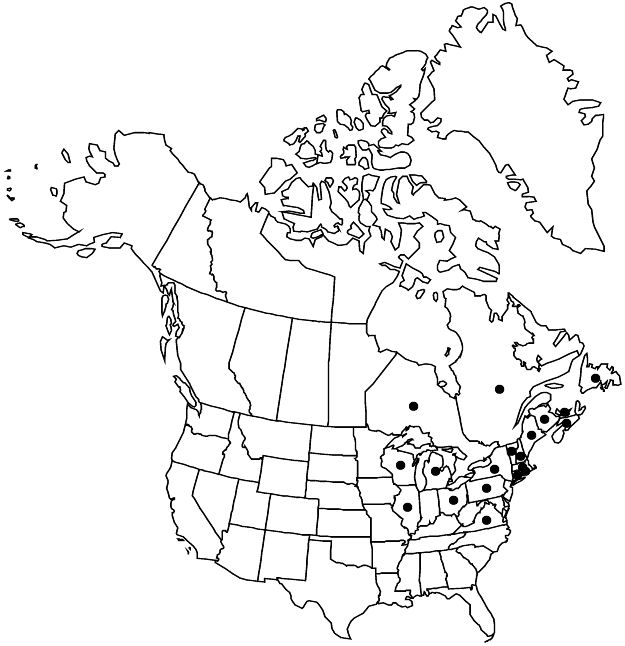Difference between revisions of "Rosa cinnamomea"
Sp. Pl. 1: 491. 1753.
FNA>Volume Importer |
imported>Volume Importer |
||
| (2 intermediate revisions by 2 users not shown) | |||
| Line 28: | Line 28: | ||
|elevation=0–400 m | |elevation=0–400 m | ||
|distribution=N.B.;Nfld. and Labr. (Nfld.);N.S.;Ont.;P.E.I.;Que.;Conn.;Ill.;Maine;Mass.;Mich.;N.H.;N.Y.;Ohio;Pa.;R.I.;Vt.;Va.;Wis.;Europe;Asia (Japan;Siberia). | |distribution=N.B.;Nfld. and Labr. (Nfld.);N.S.;Ont.;P.E.I.;Que.;Conn.;Ill.;Maine;Mass.;Mich.;N.H.;N.Y.;Ohio;Pa.;R.I.;Vt.;Va.;Wis.;Europe;Asia (Japan;Siberia). | ||
| + | |introduced=true | ||
|discussion=<p>The double-flowered form of <i>Rosa cinnamomea</i> is often found in eastern North America, where hip formation and achene development are infrequent. The species is distinguished by its mostly convoluted stipules, abaxially glaucous leaflets, and basal achenes.</p> | |discussion=<p>The double-flowered form of <i>Rosa cinnamomea</i> is often found in eastern North America, where hip formation and achene development are infrequent. The species is distinguished by its mostly convoluted stipules, abaxially glaucous leaflets, and basal achenes.</p> | ||
|tables= | |tables= | ||
| Line 52: | Line 53: | ||
|publication year=1753 | |publication year=1753 | ||
|special status=Introduced | |special status=Introduced | ||
| − | |source xml=https:// | + | |source xml=https://bitbucket.org/aafc-mbb/fna-data-curation/src/2e0870ddd59836b60bcf96646a41e87ea5a5943a/coarse_grained_fna_xml/V9/V9_142.xml |
|subfamily=Rosaceae subfam. Rosoideae | |subfamily=Rosaceae subfam. Rosoideae | ||
|tribe=Rosaceae tribe Roseae | |tribe=Rosaceae tribe Roseae | ||
Latest revision as of 22:54, 5 November 2020
Shrubs, forming dense thickets. Stems ± flexuous, 10–20 dm, densely branched; bark dark red to brown, glabrous; infrastipular prickles paired, erect, sometimes curved, stout, 4–7 × 2.5–3 mm, base glabrous, internodal prickles absent, aciculi rare. Leaves 4–8 cm; stipules often convolute, 8–15 × 3–8 mm, auricles flared, (1.5–)3–5(–7) mm, margins entire or crenate, sparsely to densely stipitate-glandular, surfaces glabrous, sometimes pubescent, eglandular; petiole and rachis without pricklets, pubescent, eglandular, sometimes sparsely or densely sessile-glandular; leaflets 5(–7), terminal: petiolule 4–9 mm, blade elliptic to ovate, 20–40 × 12–18 mm, membranous, margins 1-serrate, teeth 9–18 per side, eglandular or gland-tipped, apex acute, abaxial surfaces pale green, ± glaucous, pubescent (especially on veins) or glabrous, glandular, adaxial green, dull, sometimes sparsely pubescent. Inflorescences corymbs, 1 or 2(or 3)-flowered. Pedicels erect, slender, 7–17 mm, glabrous, eglandular; bracts 2, ovate or ovate-lanceolate to obovate, 6–15 × 6–10 mm, margins ciliate, stipitate-glandular, surfaces mostly pubescent, sometimes glabrous. Flowers 3–5 cm diam.; hypanthium hemispheric, 4–5 × 3–4 mm, glabrous, eglandular, neck absent; sepals spreading, lanceolate or ovate-lanceolate, 18–25 × 2.5–4 mm, tip 5–8 × 1–2 mm, margins entire, rarely pinnatifid, lobes 1 or 2, abaxial surfaces pubescent, eglandular or sparsely sessile- or, rarely, stipitate-glandular; petals double, rarely single, pinkish purple, 9–15 × 9–11 mm; carpels 25–35, styles exsert 4 mm beyond stylar orifice (2.5–3 mm diam.) of hypanthial disc (4–4.5 mm diam.). Hips scarlet, globose, 9–11 × 8–10 mm, fleshy, glabrous, eglandular, neck absent; sepals persistent, erect or spreading, hips rarely maturing. Achenes basal, 17, dark tan, 3–3.5 × 1.5 mm. 2n = 14.
Phenology: Flowering Jun–Jul.
Habitat: Roadsides, old pastures, fencerows, fields, stream banks, near dwellings
Elevation: 0–400 m
Distribution

Introduced; N.B., Nfld. and Labr. (Nfld.), N.S., Ont., P.E.I., Que., Conn., Ill., Maine, Mass., Mich., N.H., N.Y., Ohio, Pa., R.I., Vt., Va., Wis., Europe, Asia (Japan, Siberia).
Discussion
The double-flowered form of Rosa cinnamomea is often found in eastern North America, where hip formation and achene development are infrequent. The species is distinguished by its mostly convoluted stipules, abaxially glaucous leaflets, and basal achenes.
Selected References
None.